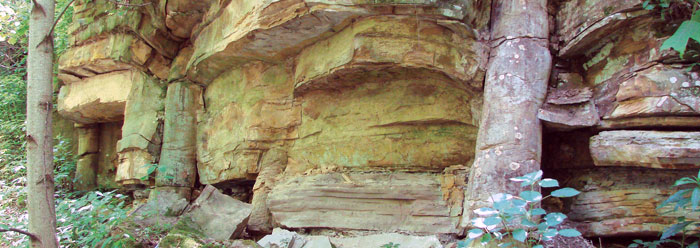The term "polystrate" was coined to describe a fossil which is encased within more than one (poly) layer of rock (strata) thus "polystrate or "many layers." A wonderful story can be told by these fossils which invalidates the commonly held uniformitarian idea of slow and gradual accumulation of sediments.
For years evolution's twin theory was the principle of uniformity, that things have been "uniform" throughout the past. Advocated by Charles Lyell in the early 1800s, it became the "politically correct" position with its dictum "the present is the key to the past." Since the 1960s or so, strict uniformitarian thinking has relaxed somewhat, but still nothing too catastrophic is considered, such as the Flood of Noah's day.
We first note that fossil-bearing sedimentary rock consists (with few exceptions) of sediments which accumulated in a watery environment and are now hardened into sedimentary rock. Rock units are separated by obvious bedding planes, but frequently even small-scale banding is visible, interpreted as yearly indicators, much like tree rings in a tree. Counting these yearly bands of dividing rock thickness by today's meager accumulation rates, gives support to the millions of years concept of geological ages. The question is, were past sedimentation rates equivalent to today's rates, (or perhaps higher to account for minor catastrophes) or were they accomplished by processes whose rates, scales, and intensities are not occurring, or perhaps not even possible today. Polystrate fossils can address this question.
Polystrate fossils are the exception to the rule, but are known to all geologists. Frequently trees are found protruding out of coal seams into the strata above, and perhaps extending into a second coal seam, several feet above the first. I have been in many coal mines and have seen such fossils (or their remaining impressions), in nearly all. I've also discovered thin, reed-like stem, transgressing numerous layers. Furthermore, I've seen hundreds of individual fossils whose body width exceeds the width of the banded layers in which they are encased. Obviously the layers cannot be the result of slow accumulations, for a dead fish, for example, will not remain in an articulated condition for several years while sediment accumulates around it. No, it must be quickly buried in order to be preserved at all. Some of the big polystrate trees transgress strata otherwise thought to have required tens of thousands of years. Obviously, the entire section required less time than it takes a tree to rot and fall over.
It has now been well demonstrated that rapidly-moving, sediment-laden fluids can result in an abundance of laminations and/or layers. They can be formed in lab experiments, by hurricanes, and were even formed by catastrophic mud flows associated with the eruption of Mount St. Helens.
A better interpretation of past deposits would stem from acceptance of rapid intense geologic processes, such as Noah's Flood.
*Dr. John Morris is the President of ICR.























